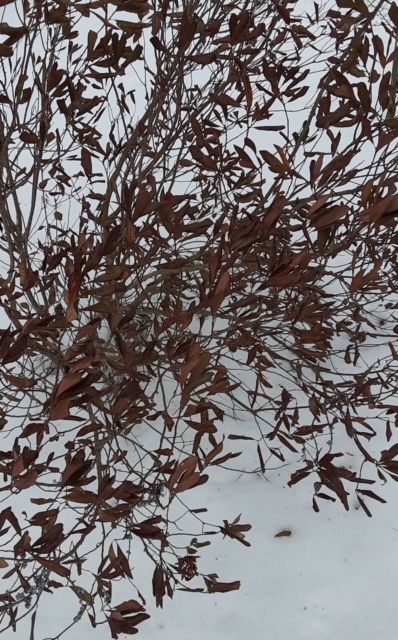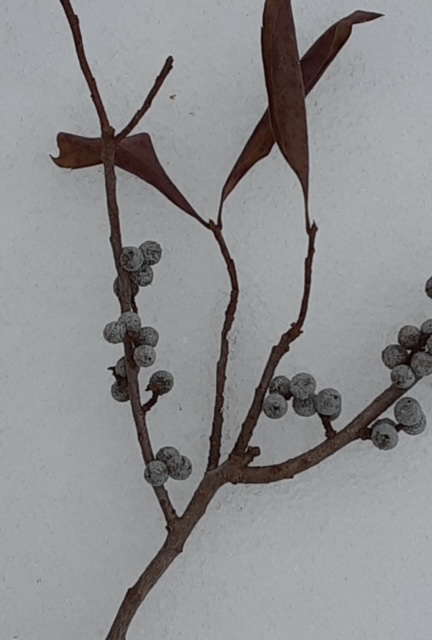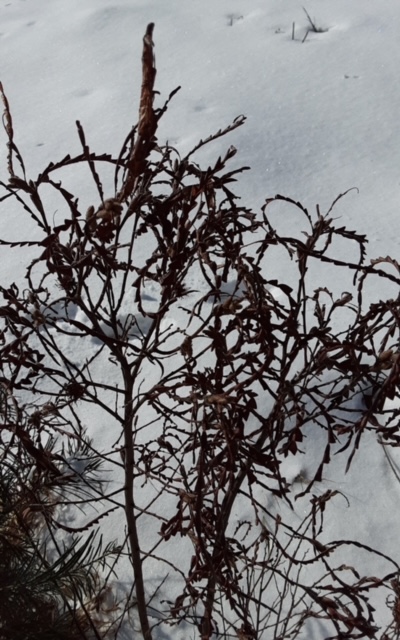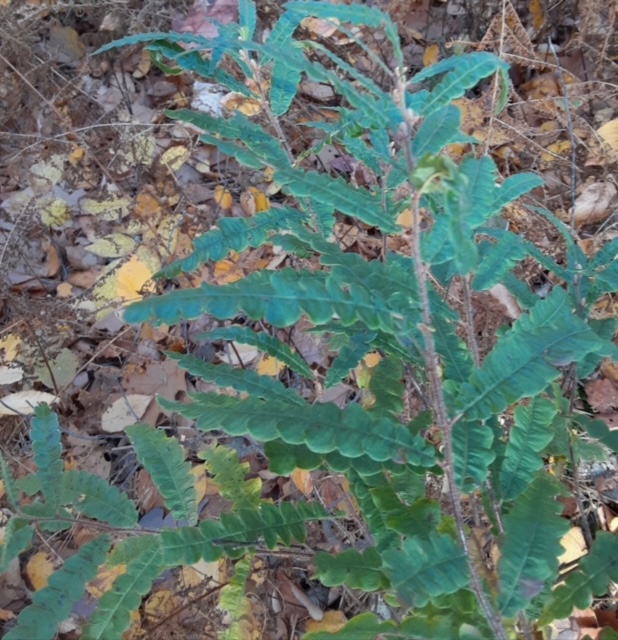By: Susan Sprout
Northern Bayberry
It has been a joy for me this snowy season to search out my favorite plants and trees in their winter garb in order to share them with you. Some lose leaves, some keep leaves, some have easily identified bark, some retain scent, some have recognizable fruits like seedpods or berries. Northern Bayberry, (Myrica pensylvanica), native to eastern North America, has leaves, scent and fruits! It is a member of the MYRICACEAE Family like Sweet Fern, last week’s post.

This bushy perennial shrub can be found growing in a wide range of soil conditions, especially relatively poor sandy ones, because of the beneficial symbiotic relationship with colonies of bacteria growing in its root nodules. The Bayberry provides sugars and a variety of minerals for the bacteria, while the bacteria uses its complex biochemical processes to transform atmospheric nitrogen (N2), unusable by the plant, into NH3, an ammonia that provides nutrition for it.

Look for it in open woods, old fields, especially around old homesteads, where early settlers who made their own candles could easily have sent their children out to pick large amounts of the wax-covered grayish-green berries. After boiling the berries in water to melt off the fragrant wax, it was cooled, removed from the water, and re-melted for pouring into candle molds or for the slow process of dipping wicks into it. The resulting candles were treasured for their scent when burning, particularly for holiday celebrations.
Sweet Fern
Sweet Fern (Comptonia peregrina) is a flowering shrub, not a fern at all! A member of the Bayberry Family, MYRICACEAE, and the only living species in its genus, it is a native of Eastern North America.

Because it is a nitrogen-fixer, I like to think that this plant may have been an important soil builder-upper of the glaciated areas of PA, following the retreating ice sheets of the Pleistocene Era. Its long, thin notched leaves have an exotic look about them, as well as an amazing spicy, aromatic scent when crushed. During winter, the leaves will turn from olive green to a coppery-brown color, but retain their scent. That is probably why American colonists used them to stuff mattresses…for sweet dreams and to repel pesky fleas and lice.

I have found colonies of Sweet fern in open woods, fields, and marsh edges, full sun to part shade. If you are out camping and bothered by flying insects, throw a handful of Sweet fern on your campfire coals for an instant and great smelling smudge.
Find out what’s underfoot with NPC member and environmental educator, Susan Sprout! Catch up on past issues of Underfoot: Introduction & Bloodroot, Trout Lily & Coltsfoot, Blue Cohosh & Dutchman’s Breeches, Ground Ivy & Forget-Me-Nots, Goldthread & Wild Ginger, Common Mullein & Sweet Woodruff, Aniseroot & Butterfly Weed, Myself , Jewelweed & Soapwort, American Pennyroyal & Great Lobelia, Boneset & Common Ragweed, Pokeweed & Blue Chicory, Prickly Cucumber & Wintergreen, Beech Drops & Partridge Berry, Pipsissewa & Nostoc, Witch Hazel, Plantsgiving, Black Jetbead & Decorating with Winterberry, Wild Bergamot & Bald Cypress Tree, Galls & Bittersweet, American Beech & Bagworm, Seedpods & American Chestnut.

